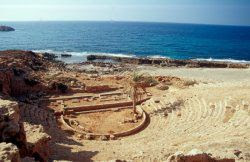Thursday, October 4, 2007
Traditional Music Touring Libya
http://ie.youtube.com/watch?v=Yw28B_xflHk
Libyan Currency
http://ie.youtube.com/watch?v=UYvG2b9GMK0
Libyan (Zukrah Music)
http://ie.youtube.com/watch?v=9X0IsGhyZS8
Hagalla Dance
http://ie.youtube.com/watch?v=KtbKnq5ZjXM
Libyan Football
http://ie.youtube.com/watch?v=rESfdZSM2Sw
Hamza V Abo Jahil
http://ie.youtube.com/watch?v=3lOXO51qkrs
Libyan Rab
http://ie.youtube.com/watch?v=Ow8_OBkEanM
Libyan Wedding party mens
http://ie.youtube.com/watch?v=P4h5Z5BUCrA
Libyan Band Rock music
http://ie.youtube.com/watch?v=HLrSq4-4UqY
Best Player In Libya
http://ie.youtube.com/watch?v=psBvWJSGiSU
Shooting down Libyan Mig Fighter by American
http://ie.youtube.com/watch?v=VJMSbkdW26M
Libyan Kid vs . Sheep
http://ie.youtube.com/watch?v=vGKuoq0FU7I
Tuesday, May 22, 2007
Apollonia. سوسة







Ancient Apollonia, which was Cyrene’s port for a thousand years and its ruins form an essential part of the whole archeological complex, originally constructed by the Greeks when they began to develop their naval merchant fleets, modern Sousa was founded in 1897as a colony of Muslim refugees from Crete and there is a decindely non African strain apparent in its population. It was extensively rebuilt in the Italian occupation as a port for a coastal shipping
The first important monument to be encountered is the Extra-Mural Church, only a corner of the outer walls of this church is visible. The church is remarkable for the traces of a triple apse – Triconchos- surviving in the cactus garden at its east end, the Hellenistic City Walls of Apollonia are well preserved through their landward course, continue toward The Theatre which lies immediately outside the eastern rampart, it is of a Greek type and of Hellenistic date; but it was remodeled under the Emperor Domitian 92-96 A.D, another monuments are the three churches Western, eastern and Central built around the 6th century.
Ghadames
Benghazi
Tripoli
Monday, May 21, 2007
Cyrene قورينا










أسست في حدود سنة 631 ق. م عن طريق بعض المغامرين الإغريقوكان باتوس أول حاكم للمدينة ولمدة 40 سنة. وشهدت أوج ازدهارها من نشاط زراعي وتجاري في القرن الرابع قبل الميلاد.
تأريخ المدينة
قد تبعث اداريا كل الامبراطوريات التي تعاقبت على حكم شمال ليبيا من الجمهوريين سنة 414 ق م إلى الإسكندر الأكبر والحكام الاغريق سنة 332 إلى الرومان 96 ق م إلى البيزنطيين 324 م إلى الفتح الاسلامي 635 م.
عظمة المدينة
تتميز المدينةبالحمامات اليونانية ومعبد (زيوس) الفخم ومعبد أبولو وغيره من المعابد والاغورا ومجلس الشورى، وقلعة الاكرابوليس. وفي العهد الروماني أدخل بعض التحويرات على المباني اليونانية وشيد الكثير من المباني الجديدة ومنها الحمامات الرومانية والمسرح ورواق هرقل والكثير من المعابد والنصب، والسور الخارجي الذي بني في القرنين الأول والثاني للميلاد، كما يوجد العديد من الكنائس التي تعود للعهد البيزنطي.
المدينة في الانجيل والتوراة
ذكرت شحات (قورينة) في النسخة العربية من الانجيل باسم القيروان: مرقس 15-21 "فسخّروا رجلا مجتازاً كان آتيا من الحقل وهو سمعان القيرواني ابو ألكسندرس وروفس ليحمل صليبه". كما ذكرت في التوراة في سفر المكابيين
http://tourlibya.orgfree.com/cyrene.htm
http://www.youtube.com/watch?v=L7ASMduHMUE















